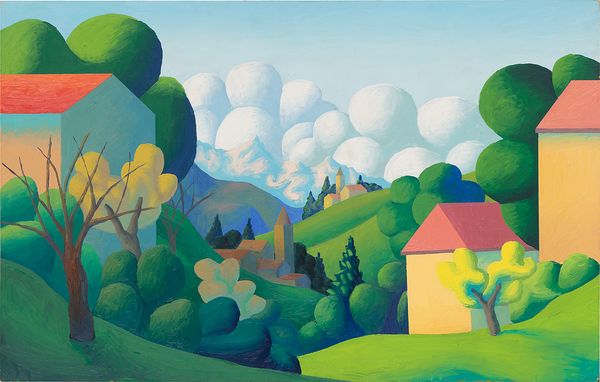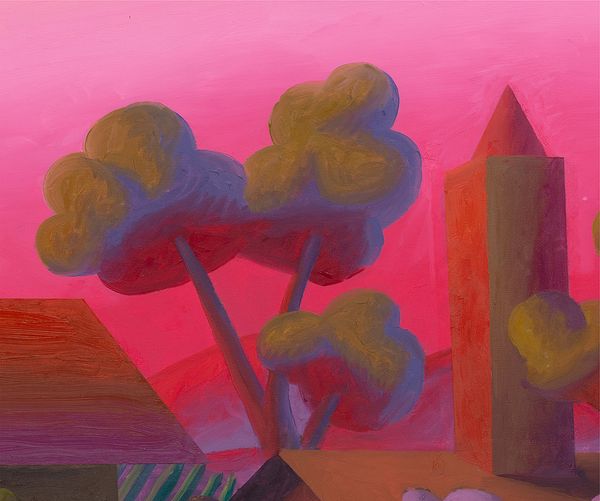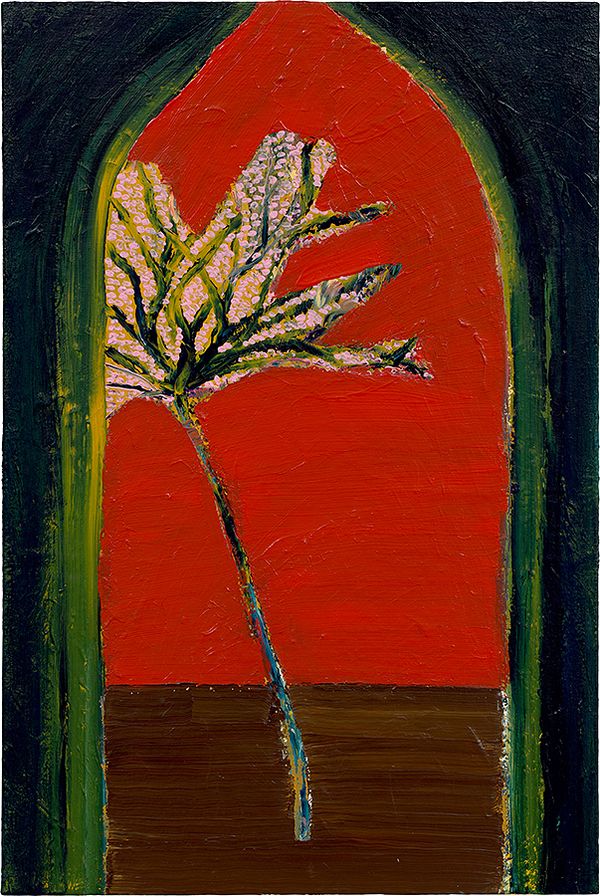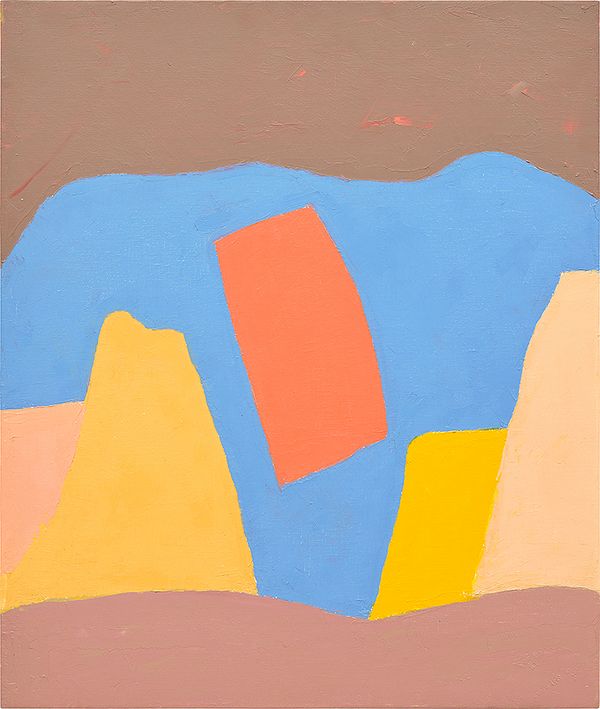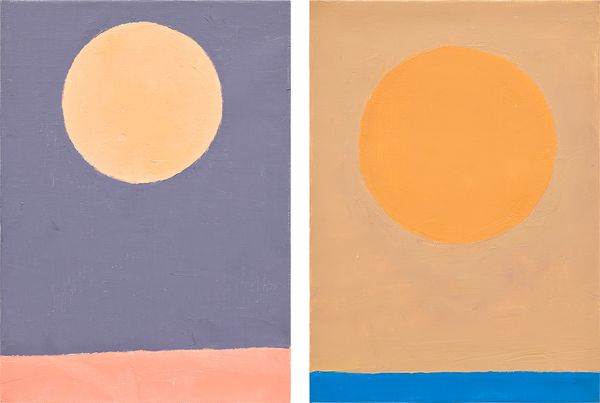Salvo, Se Elena mi chiede un quadro rosso tra zero e tutto questo è quello che posso, 2009. 20th Century & Contemporary Art Day Sale, Afternoon Session.
In many ways, our identities are shaped by our sense of home. And not just the structures we live in, but by the landscape that surrounds us. How many of us, in childhood, gazed out a window to daydream, imagining fantastical places based on the landscapes that we know and identify with? For many artists, this sense of wonder is not lost with maturity, rather it is cultivated over time, as their personal visions become outwardly expressed through landscapes that represent much more than nature.
The landscape as a subject and genre was not always cherished. The French Academy in the 17th century, for example, ranked it fourth in importance out of the five genres, above only still life. Yet, it was arguably landscape in the eyes of the Impressionists (Claude Monet’s groundbreaking Impression Sunrise comes to mind) that was used to fracture such traditional notions, and the genre continued to inspire the innovative artists who brought forth everything from Modernism to the contemporary interpretations we see today.
Below, we look to see what the genre can mean to four artists of varying ages and identities and discover how they combine personal memories and sensations of nature in the creation of striking works that are more than just geography, but intimate expressions of their imaginations and experiences.
Salvo
Salvo, Prima Primavera, 1996. 20th Century & Contemporary Art Day Sale, Afternoon Session.
The Italian artist Salvo spent much of his early career producing primarily conceptual works, often sculptural or text-based. In 1973 the artist shifted his approach to focus on figurative painting, and developed a practice grounded in landscape that he would pursue for the remainder of his life. Rather cleverly, it was in that same year that he created one of his last conceptual works: a marble sculpture inscribed with the text “SALVO È VIVO.”
His landscape paintings explore complex ideas around memory, time, and identity, employing a masterful use of color and light. Salvo traveled extensively, and his memories of various landscapes experienced around the world inform his work with an alluringly loose specificity. We can sense aspects of the artist’s early text practice in the title of Se Elena mi chiede un quadro rosso tra zero e tutto questo è quello che posso, which roughly translates to “If Elena asks me for a red painting between zero and all, that’s what I can do.” Here, his infectious sense of light drapes the scene in a captivating glow that leaves the sensation of an imagined place, devoid of time. Prima Primavera is yet another characteristic Salvo landscape, absent of any human figures. The spherical shape of the trees is imaginative, almost playful, and an airy spring light pervades the work.
Salvo, Se Elena mi chiede un quadro rosso tra zero e tutto questo è quello che posso (detail), 2009. 20th Century & Contemporary Art Day Sale, Afternoon Session.
Perhaps most intriguing about the artist’s life is the way his works moved away from the outwardly conceptual early work towards representation through the 1980s — a period when much of the art world was going exactly the opposite direction. Today’s art culture is responding strongly to this era of Salvo’s work, with recent acclaimed exhibitions at numerous galleries and institutions including Perrotin and Gladstone. It’s important to note, however, that the philosophical intent behind his work didn’t exactly reverse as he charted this new course. As Pier Giovanni Castagnoli writes in Seasons of history, seasons of painting, “Reading through his declarations, Salvo, himself, appears to be the director and main actor of such a skillfully orchestrated performance, which has thrown many of his critics off track.” He goes on to explain that we must accept Salvo’s pictorial work as an ultimate outcome of his conceptual process. Indeed, in perhaps his final artistic act, when Salvo died in 2015, that earlier 1973 marble sculpture was turned around on the artist’s instructions to reveal additional text on the opposite side: “SALVO È MORTO.”
Marina Perez Simão
Marina Perez Simão, Untitled, 2021. 20th Century & Contemporary Art Day Sale, Afternoon Session.
Lyrical, undulating, and imaginative, Marina Perez Simão’s 2021 work Untitled is a distinct example of her practice. Almost every element of the scene can be considered a visual ambiguity, but it’s subtle. For example, is the light source the vibrantly glowing sky or the purple sphere? Is that purple sphere the sun or the moon? Are the blue and green waves water or fields of vegetation? Are the swirls of darker pigment at left a depiction of foliage or dissipating smoke? In this sense, her imagery is familiar, but operates in an in-betweenness that is as captivating as it is mysterious.
“I have to have a feeling that I’ve never seen this before in real life. But not in an obvious way.”
—Marina Perez Simão
Blurring lines between the figurative and the abstract, the artist has suggested that her landscapes are more rooted in depicting the feeling of living in a place than a realistic image of it. Simão grew up in the mountains of Minas Gerais in Brazil, where the visual effects of nature on her surrounding landscape created a lasting anchor to memory. Her process today is based on the accumulation and juxtaposition of memories and images, a sort of visual embodiment of a dream logic where nothing needs to be quite resolved. In addition to her own personal experiences, these juxtapositions also include references to philosophy and literature. Her works build off each other, creating an ongoing inquiry and visual language over time.
On the rise, Simão is represented by Pace Gallery and her first solo show with the gallery was presented in London last October to great acclaim. On her landscape work, Samanthe Rubell has said that Simão’s “investigation of painting’s interplay with memory and literature imbues her work with a new, conceptual dimension that makes her vision a singular one.” Her work is in several public collections, including the Musée d’Art Moderne et Contemporain de Saint-Étienne in France and The Ekard Collection in the Netherlands, among others.
Matthew Wong
Matthew Wong, Blue Tree, 2016. 20th Century & Contemporary Art Day Sale, Afternoon Session.
Landscape was the principal subject for Chinese-Canadian painter Matthew Wong, whose life was cut tragically short in 2019. Blue Tree is a defining example of his practice from the mid-2010s, created just two years before his breakthrough exhibition at Karma in New York. The work’s alluring depiction of a single tree, on the verge of the surreal, represents an emotional sense that many viewers garner from his works — a particularly contemporary sense of loneliness and alienation. Rising to international fame just before the onset of the pandemic with his second show at Karma, it’s no wonder his works captivated a global audience through our own period of isolation. Wong's works continue to fascinate us, as demonstrated by this year’s retrospective at Boston’s Museum of Fine Arts and through continued record-breaking auction results.
Wong was an artist with an omnivorous imagination who lived and breathed art with each waking moment. Confessing that he preferred a somewhat solitary life, each day he spent countless hours daydreaming, sketching, watching films, and photographing on walks alone. The sights taken in during each of these activities would intuitively influence his conception of imagined landscapes. With an MFA in photography from the City University of Hong Kong, he trained himself in the craft of painting, developing a technique that blended contemporary and traditional Eastern influences with European Modernism, Impressionism, Post-Impressionism, and Pointillism. In Blue Tree, it’s the striking use of color and the framing of the composition that first draws us in, our eyes immediately taken to the lone tree depicted in the work. The branches of which set the stage for Wong’s virtuosic, expressive, and delicate impasto brushwork that has captivated art lovers worldwide.
Matthew Wong, Blue Tree (detail), 2016. 20th Century & Contemporary Art Day Sale, Afternoon Session.
Despite his Western influences, Wong’s eye reveals just how much those artistic references are themselves in discourse with Eastern traditions. After all, many of the artists to which Wong is often compared — Edvard Munch, Vincent Van Gogh, Gustav Klimt, et al. — were in turn influenced by Asian art. In Blue Tree, the stark composition — characteristically framed as though the viewer is alone in an interior gazing outward at an impossible landscape — is dominated by insistent strokes of cadmium red. One can’t help but be reminded of this color’s Eastern associations with fortune and happiness. This hue is even reminiscent of the traditional red envelopes exchanged as gifts at the Lunar New Year. Perhaps it’s in the visual resolution of these contradictions between East and West, contemporary and historic, joy and isolation, that our eyes find something so authentically communicative — at once familiar and irresistibly fresh.
Etel Adnan
Etel Adnan, Untitled, 2016. 20th Century & Contemporary Art Day Sale, Afternoon Session.
Etel Adnan moved seamlessly between writing poetry, novels, and plays, in addition to creating visual art in multiple mediums that showcased her distinctive sight for landscape and its forms, shapes, and colors. Tellingly, she worked on a flat surface, placing her canvas on her writing table. The results are works that privilege a flattened pictorial plane as they present abstractions of the landscape that she lovingly observed from her homes in Beiruit and Sausalito, California.
“…my painting is very much a reflection of my immense love for the world, the happiness to just be, for nature, and the forces that shape a landscape.”
—Etel Adnan
Untitled is from the last five years of her life and represents her continued fascination with the sun as a presence. As she did with many elements of nature, Adnan often spoke of the sun as a companion and spiritual guide. The works on offer together present a compelling look at her repeated return to the sun and the moon. There’s an integrity to the stark compositions, glowing colors, and deceptively simple shapes that imbue these works with an expressive immediacy as profound as the natural world.
Left: Etel Adnan, Le poids de la lune 17, 2018. Right: Etel Adnan, Le poids du monde 34, 2017. 20th Century & Contemporary Art Day Sale, Afternoon Session.
When Etel Adnan passed in 2021 at the age of 96, the world lost a singular Arab-American cultural voice. Since then, her work has continued to be celebrated globally. Adnan’s works have been featured in solo exhibitions in institutions including Pera Art Museum in Istanbul, Aspen Art Museum in Colorado, MUDAM Luxembourg, San Francisco Museum of Modern Art, among others. Her works have also been featured in Documenta 13 and the 2014 Whitney Biennial.
Discover More from 20th Century & Contemporary Art Day Sale, Afternoon Session >
Recommended Reading

